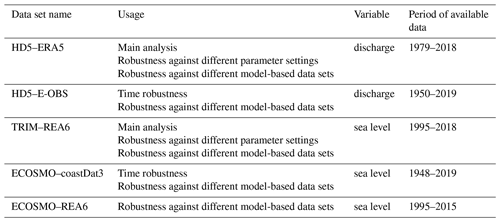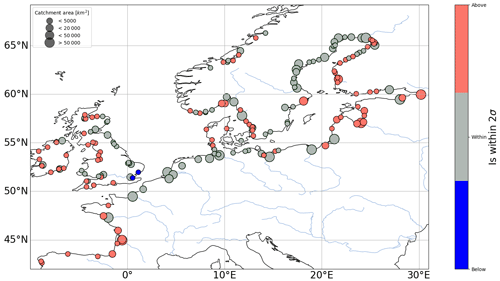the Creative Commons Attribution 4.0 License.
the Creative Commons Attribution 4.0 License.
Compound flood events: analysing the joint occurrence of extreme river discharge events and storm surges in northern and central Europe
Philipp Heinrich
Stefan Hagemann
Ralf Weisse
Corinna Schrum
Ute Daewel
Lidia Gaslikova
The simultaneous occurrence of extreme events gained more and more attention from scientific research in the last couple of years. Compared to the occurrence of single extreme events, co-occurring or compound extremes may substantially increase risks. To adequately address such risks, improving our understanding of compound flood events in Europe is necessary and requires reliable estimates of their probability of occurrence together with potential future changes. In this study compound flood events in northern and central Europe were studied using a Monte Carlo-based approach that avoids the use of copulas. Second, we investigate if the number of observed compound extreme events is within the expected range of 2 standard deviations of randomly occurring compound events. This includes variations of several parameters to test the stability of the identified patterns. Finally, we analyse if the observed compound extreme events had a common large-scale meteorological driver. The results of our investigation show that rivers along the west-facing coasts of Europe experienced a higher amount of compound flood events than expected by pure chance. In these regions, the vast majority of the observed compound flood events seem to be related to the cyclonic westerly general weather pattern (Großwetterlage).
- Article
(4583 KB) - Full-text XML
- BibTeX
- EndNote
Coastal flooding is one of the most frequent, expensive, and fatal natural disasters. In the US alone, it dealt USD 199 billion in flood damages from 1988 to 2017 according to Davenport et al. (2021). For Europe, Vousdoukas et al. (2018) projected an increase in annual costs caused by coastal floods of up to USD 1 trillion in 2100 for Representative Concentration Pathway 8.5 (RCP8.5). Furthermore, more than 600 million people live in coastal areas that are less than 10 m above sea level and less than 100 km from the shore (United Nations, 2017; McGranahan et al., 2007). Drivers for floods are storm surges, waves, tides, precipitation, and high river discharge (Paprotny et al., 2020). The area of the river in which two or more of these drivers influence the water level are called transition zones (Bilskie and Hagen, 2018). Additionally, floods can also be the result of failures of critical infrastructure like hydropower dams or flood defences (European Commission and Directorate-General for European Civil Protection and Humanitarian Aid Operations, ECHO, 2021).
The IPCC special report on Managing the Risks of Extreme Events and Disasters to Advance Climate Change Adaptation (SREX) defined compound events as
(1) two or more extreme events occurring simultaneously or successively, (2) combinations of extreme events with underlying conditions that amplify the impact of the events, or (3) combinations of events that are not themselves extremes but lead to an extreme event or impact when combined. The contributing events can be of similar (clustered multiple events) or different type(s) (Seneviratne et al., 2012).
A more general definition was proposed by Leonard et al. (2014), who defined it as “an extreme impact that depends on multiple statistically dependent variables or events”. This study focuses on compound flood events that occur when large runoff from, for example, heavy precipitation, leading to extreme river discharge, is combined with high sea level (storm surge). Because it is not possible to take local properties like topography into account, we will denote these “potential compound flood events” as “compound flood events” in the following text for the sake of readability.
The occurrence of extreme discharge and storm surge events either simultaneously or in close succession can lead to severe damage, which greatly exceeds the damage those events would cause separately (de Ruiter et al., 2020; Xu et al., 2022). Several studies conducted over previous years have shown the importance and catastrophic nature of compound flood events for various locations. One example is the flooding of Jacksonville (Florida) where the surge caused by the strong winds of Hurricane Irma stalled the fluvial discharge (Juarez et al., 2022). Considering data from 1901–2014 and gauges from northwestern Europe, Ganguli and Merz (2019) found opposing trends in the magnitude of compound flood events depending on the latitude of the gauge. They reported increases at midlatitudes (47 to 60∘ N) and decreases for gauges at high latitude (> 60∘ N). Svensson and Jones (2002) analysed the dependence of high sea surge, river flow, and precipitation in the UK. They found a higher number of compound flood events on the western coast than on the eastern coast, while Paprotny et al. (2020) demonstrated that hydrodynamic models are capable of identifying real-world compound flood events in northwestern Europe. Many studies found that the assumption of independence between drivers leads to an underestimation of the occurrence rate of compound events.
In addition to the large-scale studies mentioned above, a large number of studies exist that focus on smaller regions. Examples are the studies of van den Hurk et al. (2015) and Santos et al. (2021a), which both analysed a near flood event in the Netherlands in January 2012, which was caused by a combination of extreme weather conditions. Additionally, there have been studies modelling compound flood events in rivers on a local scale such as for the Zengwen River basin in Taiwan by Chen and Liu (2014), the Shoalhaven River in Australia by Kumbier et al. (2018), and the Min River in China by Lian et al. (2013).
A direct comparison between different studies is hampered by the use of different approaches, data, analysis periods, and other factors. There are currently no established standards for detecting extreme events. For example, the thresholds for extreme events were calculated by utilising the return period (Bevacqua et al., 2019), utilising a certain number of events per year (Hendry et al., 2019; Ganguli et al., 2020), or utilising a percentile approach (Paprotny et al., 2018a). Other studies chose block maxima to detect extreme events (Engeland et al., 2004). The exact parameters are chosen nearly arbitrarily by the authors, with the only common goal being a low number of events so that they can be declared as “extreme”. Nonetheless, there have been some studies that investigated the sensitivity of their results. Zheng et al. (2014) compared three classes of statistical methods and found that the point process method overestimated the dependence of extremes while the conditional method underestimated it. In a similar vein, Jane et al. (2022) assessed that their estimates of the potential for compound events were highly sensitive to the statistical model setup. Basically, all studies found a correlation between drivers to a certain extent.
The influence of climate change on the frequency of compound flood events in Europe has been investigated by different studies. The increasing sea level due to climate change and higher occurrence of strong precipitation pose an increasing threat to important economic centres around the world and the people living there (Müller and Sacco, 2021). Feyen et al. (2020) projected that in the event of a high-emissions scenario, the damages caused by floods would represent a considerable proportion of some countries' national gross domestic product (GDP) at the end of the century. Studies that investigated the effect of climate change on compound flood events focused on various regions of interest, for example, Bevacqua et al. (2019) on all of Europe, Poschlod et al. (2020) on Norway, Bermúdez et al. (2021) on the rivers Mandeo and Mendo in Spain, and Ganguli et al. (2020) on northwestern Europe. Bevacqua et al. (2019, 2020) reported a strong increase in the occurrence rate of compound flooding events for the future, especially for northern Europe, mainly due to the stronger precipitation as the result of a warmer atmosphere carrying more moisture. Contrarily, Ganguli et al. (2020) reported a lower risk of compound flooding due to a lower dependence between surges and river discharge peaks.
Many studies utilised multivariate extreme value theory and copulas to describe the data distribution of two or more time series and investigate the dependence between extreme events (Hao et al., 2018). In climate research, the amount of available data points is often very small, with many studies operating at merely 30 extreme events. This can cause large uncertainties when trying to evaluate the tail dependence of the distribution (Serinaldi, 2013; Joe, 2014). An alternative approach is based on Monte Carlo simulations where the dependence between joint extremes is studied by randomly rearranging one of the time series. Given our small sample size, in the following we used such an approach to avoid the uncertainties associated with the use of copulas in small samples.
In the present study, we analyse compound flood events by focusing on the question of whether they occur more often than by pure coincidence. Utilising several available large-scale data sets allowed us to conduct this analysis for northern and central Europe, instead of focusing on a single river. Furthermore, we wanted to investigate if spatial patterns occur and if they are caused by one common meteorological driver. To achieve this, we implemented a simple statistical method that avoids the application of copulas. For this, we randomised our data sets in a bootstrap process and investigated the number of compound extreme events in them, which resulted in a probability distribution in case of independence. Rivers with a number of observed compound extreme events outside of the 95 % confidence interval of 2 standard deviations might have a common large-scale driver. Similar studies have so far only been carried out by van den Hurk et al. (2015) for the Lauwersmeer in the Netherlands and by Poschlod et al. (2020) for Norway (in this case covering rain on snow events). To our knowledge, this will be the first recent publication investigating compound flooding in northern Europe without the use of copulas. For this, we utilised discharge and sea level data sets that were simulated based on reanalysis and hindcast data. Moreover, we investigated the robustness of the spatial patterns in our results by modifying various parameters of our method, like the thresholds for determining extreme events. Additionally, we investigated potential correlations between a river's catchment size and the number of compound flood events that occur. Finally, we examined possible drivers that could cause the occurrence of compound flood events.
The first step in determining extreme events is to define which events are considered to be extreme. There are ways to use automatic threshold approaches for detecting extreme events, like the goodness-of-fit p value (Solari et al., 2017) or the characteristics of extrapolated significant wave heights (Liang et al., 2019), but they struggle due to the diverse characteristics in the time series of drivers that cause coastal floods (Camus et al., 2021). River-specific thresholds are only feasible for case studies that can take the local properties, like flood protection or elevation of the surrounding area, into account. Therefore, a more general approach is needed that is applicable to all rivers. As described in Sect. 1, there is so far no standardised method that is generally used. Quite the contrary, every study uses its own modus operandi, each having individual reasoning for their choice.
One option is utilising block maxima for extreme event detection (Gumbel, 1958), which provides a well-spaced distribution of extreme events, e.g. one event per year, meaning one annual maximum event. However, it can miss out on events with high values, in case several events happen in the same year (Santos et al., 2021b), while also labelling lower values as extreme in years without any major events.
We, therefore, chose the peaks-over-threshold (Pickands, 1975) method to select extreme events by using percentiles, like in the works of Rantanen et al. (2021), Fang et al. (2021), Lai et al. (2021), Ward et al. (2018), and Ridder et al. (2018). While using the peaks-over-threshold method, it is important to ensure the independence of the events. It has to be prevented that, for example, a single day that slightly drops under the thresholds creates two separate events (Harley, 2017). A critical element in the analysis is the definition of a de-clustering window such that subsequent events can be considered independent. A frequently used window size is based, for example, on the typical duration of storms in the area (e.g. Harley, 2017; Camus et al., 2021). Here, we chose a de-clustering time of 3 d as used in other studies spanning larger domains (e.g. Bevacqua et al., 2019; Ward et al., 2018; Haigh et al., 2016).
Extreme events should be rare by definition, regardless of the river size, therefore only occurring scarcely throughout the year. This especially prevents the accidental analysis of events that are normally not considered extreme. On the other hand, the choice of our threshold needed to take the limited data availability into account. Hence, we were forced to choose our thresholds low enough to ensure that enough points were available for robust statistical analysis. The number of extreme discharge events can vary strongly depending on the river itself. Large rivers like the Elbe show the tendency of having very long extreme events that can last for several weeks, therefore resulting in a lower number of independent extreme events for a specified quantile threshold. Smaller rivers, however, have usually rather short extreme events and consequently a larger number of independent extremes for the same quantile threshold. While this specific approach might result in nominally different numbers of extreme events for each river, it ensures that for each river the same amount of data points exceed the threshold. Sea level also exhibits variations in event duration, albeit to a lesser extent. For the discharge of rivers we chose the 90th percentile Q90 and for the sea level the 99th percentile S99.
To test the influence of the extreme event definition on possible patterns, we additionally implemented an automatic threshold tuning that modifies the percentiles and the subsequent thresholds in such a way that they result in an average of two extreme events per year. This was done to test in Sect. 4.2 if our results remain stable under much stricter definitions of extreme events. Moreover, the threshold tuning results in an average return period of 0.5 years for extreme discharge and sea level events since the return period can be defined as
where RP denotes the return period, L the duration of the data set in years, and E the number of extreme events.
Another factor we had to take into account is the so-called lag, which characterises the temporal delay between variables reacting to the same meteorological event. Such lag can occur; for example, if a storm approaches a coast, it generates increased sea level due to stronger winds, before travelling inland where it causes higher amounts of discharge due to precipitation. Most studies, e.g. Hendry et al. (2019), tested a variety of ranges like ±5 d, while Ganguli et al. (2020) calculated the delay based on the catchment size of the river.
There is a valid argument made by Ward et al. (2018) that the delay can put high stress on the flood protection systems if the initial flood water cannot retreat fast enough before the discharge occurs. Due to the large area of our study, it is impossible to quantify the potential consequences of ongoing floods on the coastal protection system for each river. Hence, we decided to focus on joint occurrences of extreme events without any additional lag. Despite that, we tested our results in Sect. 4.2 for a lag of 3 d to investigate potential influences on our results. In our case, we used the lag as a temporal search radius around the discharge extreme event rather than a shift of the time series itself.
To identify rivers that show a higher number of compound flood events than expected by pure chance, we utilised a Monte Carlo approach. Other studies in the past also utilised data permutation; see, for example, Svensson and Jones (2002), Zheng et al. (2013), and Nasr et al. (2021). Rivers with this behaviour might indicate a common large-scale driver that causes extreme discharge and sea level at the same time. For example, Hendry et al. (2019) found that the compound events on the west coast of Great Britain have a different meteorological background than those on the east coast. A randomisation method was used to disrupt possible correlations between the data sets and see how the number of compound flood events changes in the case of independent data. First, we limited the time frame of the data sets to the late fall and entire winter season, as storm surges mostly occur in the winter season in northern Europe; see, for example, (Liu et al., 2022). For the winter season, we used a time frame from December to February, such as also done by Robins et al. (2021). At the same time, most discharge events are also limited to the winter and early spring seasons. Neglecting this seasonality would naturally lead to false-positive dependencies since seasonal events would be spread throughout the entire year instead of being mostly limited to their own season. As a result, we would see a much lower number of compound flood events in the non-randomised data, therefore suggesting a false dependence (Couasnon et al., 2020).
Afterwards, we determined the number of compound flood events by counting the joint occurrence of extreme events in the discharge and sea level data. To deal with the differing duration of discharge events, we counted the occurrence of multiple separate sea level extreme events during the same discharge event as separate compound flood events.
After determining the number of compound flood events in the original data sets, we prepared the randomisation of the sea level data. For this, we made sure that events were not split up by grouping data points of the same event together before the shuffling process. This was done to not artificially increase the number of extreme events by separating events that consist of more than a single data point. Every data point that was not an extreme event was put into its own group as the only member. The shuffling process of the groups with NumPy (Harris et al., 2020) assigned every group a weight based on the number of data points inside each group. After the shuffling process, the groups were disbanded and formed a randomised data set based on the new order. Afterwards, we performed the de-clustering process again to ensure that extreme event data points in close proximity were counted as a single event. Then we calculated the number of compound flood events for the combination of discharge data and randomised sea level data. This bootstrap process was repeated 10 000 times for each river, giving a probability distribution for each of them. The resulting probability distribution was used to determine if the initially observed number of compound flood events is within the 95 % confidence interval of 2 standard deviations (2σ).
To test the robustness of our results in Sect. 4.2, we also created an additional randomisation approach by randomly shuffling the order of the winter months throughout the sea level data. This method was easier to implement than the one used for the main analysis. For further testing, we utilised different combinations of data sets to investigate their influence on our results. Finally, we used two different time frames to see if climate change or the choice of time period have an influence on possible spatial patterns.
The domains of all catchments, regions, and seas that we mention by name for various reasons in this study can be seen in Fig. 1.
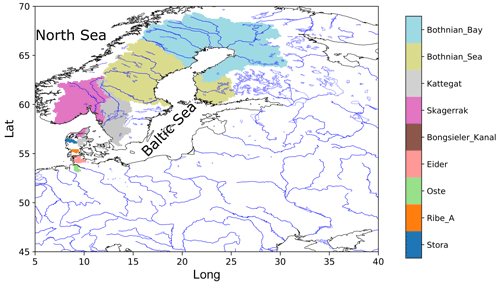
Figure 1This figure contains the catchments, regions, and seas that are mentioned by name throughout the study. The first five entries in the colour bar contain maritime zones with highlighted catchment areas of rivers that discharge into them. The last five entries show the catchment area of five rivers on the German–Danish western coast.
In order to study compound flood events, spatial and temporal consistent long time series of daily river runoff (discharge) and sea level near the coast are required. On the one hand, observed discharges are usually not available at the respective river mouths, but they are often measured at stations further inland. In addition, periods of available daily data vary considerably between the rivers, even over the considered region that has a rather good data coverage.
Consequently, we chose several model-generated data sets that provide daily data also for sea level over a time period of at least 20 years and cover northern Europe. For our analysis, we utilised several model-based data sets which varied in forcing, regions, and time frames. This was done to enable robustness tests of our analysis under a diverse set of conditions. The simulated discharges are solely caused by the atmospheric forcing and the hydrological processes over land. The influence of the sea level on discharge in the estuaries of the rivers is not considered so that this influence (e.g. Moftakhari et al., 2019) does not cause problems in the determination of river floods. These data sets were generated by using observations and reanalysis data as forcing, and they are described below. A short overview of their usage in this paper is given in Table 1.
3.1 River runoff
We utilised two daily river runoff data sets that are based on consistent long-term reconstructions by the global hydrology model HydroPy (Stacke and Hagemann, 2021) and the hydrological discharge (HD) model (Hagemann et al., 2020). The river runoff was simulated at 5 min spatial resolution covering the entire European catchment region. The HD model v. 5.0 (Hagemann and Ho-Hagemann, 2021) was set up over the European domain covering the land areas between −11∘ W to 69∘ E and 27 to 72∘ N at a spatial resolution of 5 min (ca. 8–9 km). Both data sets were published as Hagemann and Stacke (2021) and utilised in Hagemann and Stacke (2022).
3.1.1 HD5–ERA5
ERA5 is the fifth generation of atmospheric reanalysis (Hersbach et al., 2020) produced by the European Centre for Medium-Range Weather Forecasts (ECMWF). It provides hourly data on many atmospheric, land-surface, and sea-state parameters at about 31 km resolution. HydroPy was driven by daily ERA5 forcing data from 1979–2018 to generate daily fields of surface and sub-surface runoff at the ERA5 resolution. Here, the Penman–Monteith equation was applied to calculate a reference evapotranspiration following Allen et al. (1998). Then, surface and sub-surface runoff were interpolated to the HD model grid and used by the HD model to simulate daily discharges.
3.1.2 HD5–E-OBS
The E-OBS data set (Cornes et al., 2018) comprises several daily gridded surface variables at 0.1 and 0.25∘ resolution over Europe covering the area 25–71.5∘ N × 25∘ W–45∘ E. The data set has been derived from station data collated by the ECA&D (European Climate Assessment & Dataset) initiative (Klein Tank et al., 2002; Klok and Klein Tank, 2009). Using E-OBS v. 22, HydroPy was driven by daily temperature and precipitation at 0.1∘ resolution from 1950–2019. The potential evapotranspiration (PET) was calculated following the approach proposed by Thornthwaite (1948), including an average day length at a given location. As for HD5–ERA5, the forcing data of surface and sub-surface runoff simulated by HydroPy were first interpolated to the HD model grid and then used to simulate daily discharges.
Investigations by Rivoire et al. (2021) found precipitation data from ERA5 to be of higher quality than from E-OBS. As a result, we primarily focused on HD5–ERA5 due to its higher quality compared to HD5–E-OBS, as analysed in Hagemann and Stacke (2022).
3.2 Sea level
3.2.1 TRIM–REA6
COSMO–REA6 is the high-resolution regional re-analysis of the German Weather Service (DWD; Bollmeyer et al., 2015). COSMO–REA6 data were used to force the ocean model TRIM (Tidal, Residual, and Intertidal Mudflat model) for the period 1995–2018. The 2D version of TRIM–NP (Kapitza, 2008) is a nested hydrostatic shelf sea model with spatial resolutions increasing from 12.8 km × 12.8 km in the North Atlantic to 1.6 km × 1.6 km in the German Bight. Ten-metre-height wind components and sea level pressure were used as atmospheric forcing fields. At the lateral boundaries, the astronomical tides from the FES2004 atlas (Lyard et al., 2006) were used.
We chose this data set for the main analysis of our work due to the larger region it covers.
3.2.2 ECOSMO–coastDat3
The coastDat3 data set is a regional climate reconstruction for the entire European continent, including the Baltic Sea, the North Sea, and parts of the Atlantic (Petrik and Geyer, 2021). The simulation was conducted with the regional climate model COSMO–CLM (CCLM; Rockel et al., 2008). CoastDat3 covers the period 1948–2019 with a horizontal grid size of 0.11∘ in rotated coordinates, and the National Centers for Environmental Prediction–National Center for Atmospheric Research (NCEP–NCAR) global reanalysis (Kalnay et al., 1996) was used as forcing and for the application of spectral nudging (von Storch et al., 2000). CoastDat3 data were used to force the physical part of the marine ECOSystem MOdel (ECOSMO) (Schrum and Backhaus, 1999; Daewel and Schrum, 2013) for the period 1948–2019 (Bundesamt für Seeschifffahrt und Hydrographie, 2022). ECOSMO was applied at a spatial resolution of 0.033∘ longitude and 0.02∘ latitude, and its domain covers an area from 48.20333 to 65.90333∘ N and 4.034667∘ W to 30.120333∘ E. The riverine freshwater inflow was taken from a Mesoscale Hydrologic Model streamflow simulation over Europe at ∘ resolution (Rakovec and Kumar, 2022).
3.2.3 ECOSMO–REA6
For this data set, the ECOSMO model was forced with COSMO–REA6 data and covers the period from 1995–2015. The initial state was based on a simulation using coastDat2 (Geyer, 2014) forcing from 1990 to 1995. The configuration was otherwise identical to ECOSMO–coastDat3 (Sect. 3.2.2).
While the HD model domain covers the entirety of Europe, the ocean model domains of TRIM and ECOSMO cover only parts of northern Europe. Therefore, our analysis includes a different number of rivers depending on which ocean model was used to generate the sea level data, i.e. either 181 for TRIM-based data or 126 for ECOSMO-based data
3.3 Großwetterlagen
Großwetterlagen are large-scale weather patterns that form over Europe. Hess and Brezowsky (1969) classified them into 29 different regimes and six circulation types. These weather regimes can persist from a few days up to several weeks in extreme cases. We used a catalogue with this classification system, which started back in 1881 and is managed by the DWD. James (2007) stated that there is a strong correlation between the Großwetterlagen and the resulting weather in various regions.
4.1 Regional distribution of compound flood events
Figure 2 shows the distribution of compound flood events for the TRIM–REA6 and HD5–ERA5 data over northern Europe. A total of 26 % of the rivers along the coasts had eight or more compound flood events during the time period 1995–2018.
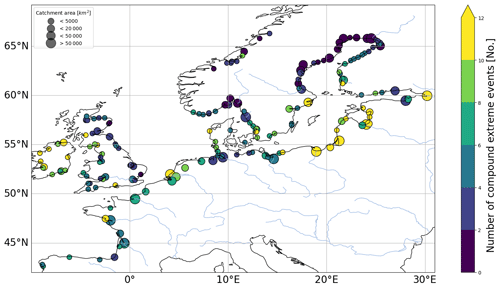
Figure 2Number of compound flood events over a period of 24 years for northern Europe based on HD5–ERA5 and TRIM–REA6 data. Circle size indicates the catchment size of the corresponding river. The number of discharge and sea level extreme events was limited to two events per year on average.
The regions with the highest number of compound flood events are Ireland and the southeastern Baltic Sea. Furthermore, the west coast of the Baltic states also shows a large amount of compound flood events. The east- and south-facing coasts of the Bothnian Bay and Bothnian Sea in the Baltic Sea, as well as Skagerrak, show the lowest frequencies of compound flood events. Similarly, the east coast of Great Britain exhibits a low number of compound flood events, in contrast to the west coast. In general, it can be seen that west-facing coasts have a larger number of compound flood events.
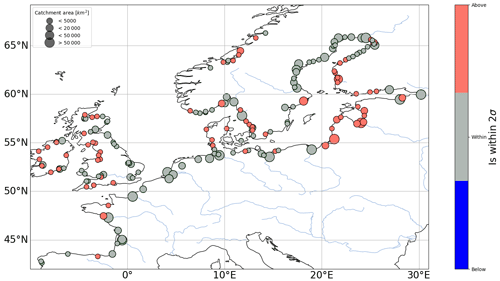
Figure 3Evaluation of compound flood events for rivers in northern Europe using HD5–ERA5 and TRIM–REA6 data from 1995–2018. The colour indicates if the amount of compound flood events is within (grey), above (red), or below (blue) the expected 2σ interval. Results are obtained for the winter season with a lag of 0 d (see Sect. 2).
Utilising our randomisation method (see Sect. 2) yielded Fig. 3, which shows if the amount of observed compound flood events for each river is within the 2σ interval produced by the randomised data sets. We see that the number of compound flood events is outside of the 2σ interval for the majority of rivers along the westward-facing coasts, while the opposite is true for the French west coast.
4.2 Robustness of the east–west pattern
To ensure that the pattern seen in Fig. 3 is not the result of sampling effect, parameter, or data choice, we tested different data sets, time periods, and parameters to see whether or not the pattern remains robust. Some images for these tests are in Appendix A for the sake of readability, and they are discussed in the following subsections.
4.2.1 Utilisation of various data sets
For the first robustness tests we analysed the combination of ECOSMO–REA6 with HD5–ERA5 (Fig. A1), ECOSMO–coastDat3 with HD5–ERA5 (Fig. 4a), and ECOSMO–coastDat3 with HD5–E-OBS (Fig. A2). The overall pattern indicating that western coasts have the tendency of showing more events than expected by pure chance remains stable throughout these different data set combinations.
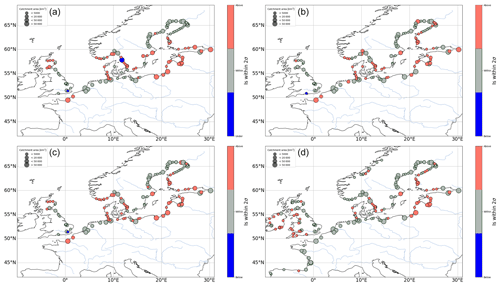
Figure 4Robustness testing. As in Fig. 3 but with different setups. (a) Utilised ECOSMO–coastDat3 and HD5–ERA5 data. (b) ECOSMO–coastDat3 and HD5–E-OBS from 1960 to 1989. (c) ECOSMO–coastDat3 and HD5–E-OBS data from 1990 to 2019. (d) TRIM–REA6 and HD5–ERA5 with increased lag from 0 to 3 d.
4.2.2 Validation for different time periods
Next, we split the ECOSMO–coastDat3 and HD5–E-OBS data into two 30-year periods, from 1960 to 1989 (Fig. 4b) and from 1990 to 2019 (Fig. 4c). The pattern of west-facing coasts having a higher number of compound flood events than expected by random sampling is persistent throughout different time periods, even though it is somewhat more pronounced in the more recent one.
Lastly, we added more months to the analysis by adding the month of November (Fig. A4) and finally expanding the time period to last from October to March of the following year (Fig. A5). This resulted in a slightly higher number of rivers being outside of the 2σ interval.
4.2.3 Changes to parameters and randomisation
As a first test, we changed the lag from 0 to 3 d, which is shown in Fig. 4d. This resulted in a slightly higher number of river catchments within the expected interval. Furthermore, we also tested the second randomisation method described in Sect. 2 in order to interrupt possible dependencies. For this, we randomised the order in which the years appear in our sea level data sets. The biggest difference with this simpler randomisation approach was that two additional rivers on the British east coast are below the 2σ deviation.
Additionally, we compared the influence of two different thresholding methods on the results, namely self-tuning thresholds (Fig. 3) and plain percentiles (Fig. A3), both described in Sect. 2. Both methods lead to nearly identical results.
4.3 A common meteorological driver for compound flood events
To see if the regions with a higher-than-expected number of compound flood events have a common large-scale meteorological driver, we analysed the meteorological situation during these events. The coordinates of those regions are available in Table 2.
Table 2Regions and their corresponding coordinates sorted in alphabetical order. They are used for the analysis in Sect. 4.3. These regions are also utilised in the visualisation of the results in Fig. 6.

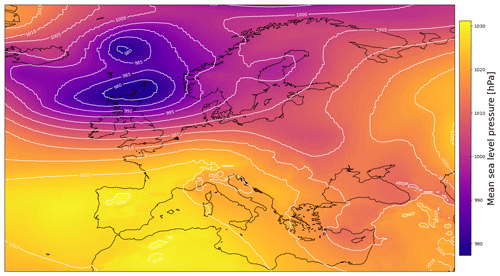
Figure 5Map of the daily mean atmospheric pressure over Europe on the 8 December 2011. The characteristic low-pressure centre of the Großwetterlage cyclonic westerly is located north of Scotland (Hersbach et al., 2020).
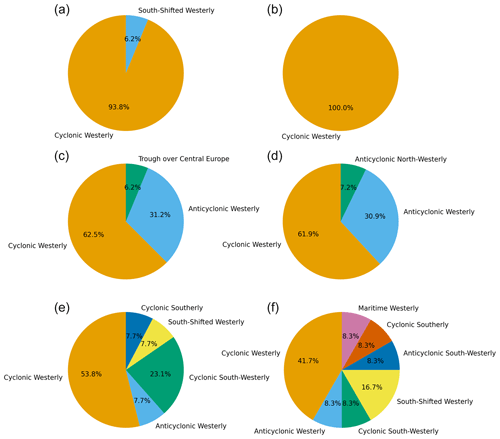
Figure 6Distribution of Großwetterlagen that occurred during compound flood events in Europe. The following regions were analysed: (a) the German–Danish west coast, (b) the west-facing coast of Sweden, (c) the west-facing coast in the Bothnian Sea, (d) the west coast of the Baltic states, (e) the west coast of Great Britain, and (f) the west coast of Ireland. Coordinates of those regions are given in Table 2.
For our analysis, we focused first on the German–Danish west coast. This coast contains the five rivers Storå, Ribe Å, Bongsieler Kanal, Eider, and Oste. Our goal was to scrutinise whether large-scale compound flood events in these rivers have a specific Großwetterlage as their common meteorological driver. For this, we decided to examine which Großwetterlage is present when at least four of the five rivers have a compound flood event simultaneously. This requirement resulted in 16 separate compound flood events based on ECOSMO–coastDat3 + HD5–ERA5 and ECOSMO–coastDat3 + HD5–E-OBS data. Fifteen of these events appeared during the Großwetterlage cyclonic westerly (Fig. 5), with only one appearing during the cyclonic northwesterly (Fig. 6a). The Großwetterlage cyclonic westerly is associated with strong westerly winds and higher-than-normal precipitation (Gerstengarbe et al., 1999) that can cause storm surges and river floods, respectively, which in combination can lead to compound flood events. Also, our analysis showed that at least 75 % of the compound flood events for each river along the German–Danish west coast happened during this specific Großwetterlage. This made it the predominant Großwetterlage during compound flood events in this area.
Similar results were found for the Swedish west coast in Kattegat and Skagerrak. There, all seven events that involved at least four rivers appeared during the Großwetterlage cyclonic westerly, based on ECOSMO–coastDat3 and HD5–ERA5 data (Fig. 6b).
In the west-facing coast of the Bothnian Sea, the cyclonic westerly remained the predominant Großwetterlage. About two-thirds of the events occurred during the cyclonic westerly and one-third during the anticyclonic westerly (Fig. 6c). In the coastal area of the Baltic states, we observed again a distribution of roughly two-thirds of the events appearing during the cyclonic westerly and one-third during anticyclonic westerly (Fig. 6d). The anticyclonic westerly is known to lead to precipitation in the area of the Baltic countries (Jaagus et al., 2010), which in combination with the southeastern wind direction are responsible for around a third of the compound flood events in the Baltic and west-facing Finnish area, due to the orientation of their coastline. For the west-facing coast of Great Britain, we found that half of the compound flood events happen during the cyclonic westerly, a quarter of the events during the cyclonic southwesterly, and the remaining during other Großwetterlagen (Fig. 6e).
Unlike the other cases, we did not observe any predominant Großwetterlage for compound events in Ireland, with the cyclonic westerly accounting for less than half of the observed Großwetterlagen during compound flood events (Fig. 6f).
Furthermore, we investigated possible correlations between the duration of a Großwetterlage and the occurrence of compound flood events. We found that compound flood events can occur during short Großwetterlagen that only last 3 d, which is by definition the minimum duration, as well as Großwetterlagen that remain over several weeks. Therefore, we did not find any direct correlation. Additionally, we did not observe any specific sequence of Großwetterlagen that leads to an increased risk of compound flood events. Finally, the kind of Großwetterlage which follows or precedes the Großwetterlage that causes a compound flood event seems to be random.
4.4 Correlation between the number of compound flood events and catchment size
We analysed if there is any connection between the catchment size and the frequency of compound flood events. For this, we plotted the number of compound flood events against the size of the catchment area of each river (Fig. 7). The catchment size of each river was obtained from the HD model grid. The analysis was done separately for rivers based on their orientation along the coasts. Furthermore, the rivers were coloured red if the number of compound flood events is above the 2σ interval of randomised sea level data, blue if below the interval, and grey otherwise, as in Fig. 3. It can be seen that there is a clear correlation between the cardinal direction of the estuary and the number of compound flood events either being inside or outside of the 2σ interval. The west-facing coasts (Fig. 7a) were mostly above the 2σ interval and showed generally a higher number of compound flood events. Contrarily, the east-facing coasts (Fig. 7b) exhibited a lower amount of compound flood events and are mostly within the expected margin. Additionally, it can be seen that the number of compound flood events declined with increasing catchment area, regardless of cardinal direction.
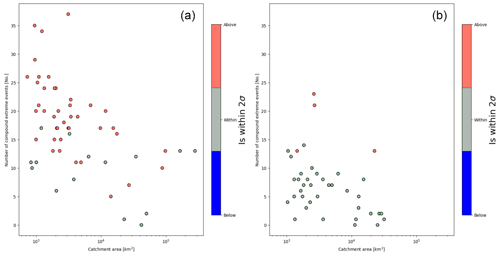
Figure 7Number of extreme events for northern Europe over a period of 24 years plotted over the river's corresponding catchment area for HD5–ERA5 and TRIM–REA6 data using percentiles. The colour displays if the amount of observed compound flood events is within the expected 2σ deviation. Contains only rivers that are either on the (a) western or (b) east-facing coasts.
In the present study, we conducted a coherent spatial analysis on the dependence of storm surges and discharge extreme events as drivers of compound flood events over northern Europe. For this analysis, we introduced a method to analyse compound events by randomising one of the data sets to generate independent data. To our knowledge, this is the first study on compound flood events over all of Europe that does not utilise copulas. As mentioned in the introduction, copulas add unknown amounts of uncertainty to the analysis. Our method on the other hand is easy to implement, and the uncertainty is given by the standard deviation. One limitation of this method is that it cannot quantify the dependence between discharge and sea level.
Using different data sets of daily discharge and sea level, we detected a distinct pattern of westward-facing coasts having a higher number of compound flood events than expected by chance (Figs. 3, 7). These coasts were located in the European storm-track corridor comprising the British Isles, northern Germany, Denmark, and southern Sweden (Feser et al., 2015). Due to the mostly prevailing western winds, the rivers on the eastern coasts showed a lower number of compound flood events, which are usually within the expected range of 2 standard deviations. This finding is consistent with the results of Paprotny et al. (2018b), who noted a strong dependency in their rank correlation for west-facing coasts in northern Europe. Khanal et al. (2019) and Kew et al. (2013) likewise reported that the most extreme events in the Rhine delta are connected to westerly winds. Similarly, Svensson and Jones (2004) reported a strong dependence between discharge and storm surge events for western Great Britain. We identified the Großwetterlage cyclonic westerly as the common meteorological driver for the occurrence of large-scale compound flood events in North and Baltic Sea regions.
In parts of the Baltic and west-facing Finnish coasts, the Großwetterlage anticyclonic westerly additionally contributed to the generation of compound flood events (about one-third). For Ireland, a distinct Großwetterlage could not be identified as a driver of compound flood events. We speculate that this might be because it offers a wide angle of attack for storm surges.
Additionally, we were able to demonstrate that the detected spatial distribution remains stable for various sources of uncertainty. Our results proved to be robust against the utilisation of different forcing data for the simulation of discharge and sea level data, parameter settings, and randomisation approaches. Furthermore, the pattern remained relatively stable despite the ongoing climate change since the 1960s. There was a certain amount of variation in the pattern, which can be attributed to randomness and the different setups. Due to the limited number of compound flood events, even small variations to their definition, like changes in the allowed lag, have a minor influence on the results. In all cases, the pattern was present, even though it was sometimes more or less pronounced.
In addition, we demonstrated that regardless of the estuary orientation, the number of compound flood events declined on average with increasing catchment size. The reason for this might be that rivers with smaller catchment areas are capable of reacting faster to precipitation that appears during the storm events, which also causes the storm surges. There is some variation in the distribution, as expected by the design of the test, which resulted in around 5 % of the data points being labelled incorrectly.
Our analysis here is associated with some caveats that have to be considered. We note that the utilisation of the 2σ interval in our analysis comprises some amount of uncertainty. As a result, it can be expected that five to nine rivers will be incorrectly labelled, based on the size of the data set. Another problem for our analysis was the very short time frame that was accessible with the TRIM–REA6 and ECOSMO–REA6 data of 24 and 21 years respectively. Furthermore, it is possible that the model-based data sets contain systematic errors. Despite the detected pattern being robust, it is possible that the absolute number of compound flood events may deviate from the actual number. Furthermore, the de-clustering time of 4 d might be too short for some of the longest rivers that may contain very long extreme events. The lack of a parametric model impedes the possibility of deriving engineering quantities such as design events used to assess the level of protection afforded by flood defence structures.
Future work can further examine these findings by using ensembles from climate models that cover longer time frames, e.g. 50 years or more. This could enable generating a distribution for the number of compound flood events, based on the compound flood events detected in the individual ensemble members. As a result, it would become possible to calculate how many compound flood events to expect on average in each river. This reduces the influence of randomness by not having to rely on the compound flood event number detected in a single data set. One potential drawback is the reliance on the capabilities of numerical models to adequately generate those compound extreme events correctly. Additionally, future studies could focus on locations in close spatial proximity along the west-facing coasts for which long time series of daily sea level and discharge data are available. They could also attempt to quantify the lag for each catchment individually, which is currently troubling for large rivers since their lag depends on the location of the precipitation. Another interesting question, which needs further investigation, is why the vast majority of compound flood events on the west coasts happen during the cyclonic westerly, while not every one of these Großwetterlagen results in compound flood events. Understanding what makes them different might offer opportunities to identify them early and set contingency plans into motion.
In order to support future risk assessments, it will be important to analyse how compound events will change under different climate scenarios and sea level rises (Zscheischler et al., 2018). First, the frequency change of general flood events with respect to the current standards for extreme events might change especially with increasing sea levels. Second, it will be interesting to analyse if our observed pattern caused by the Großwetterlage remains similar or if we will see changes to it due to, for example, changes in the occurrence rate of this specific Großwetterlage. This is important since it is well known that there have been frequency changes in the past as reported by Grabau (1987) and Dietz (2019). Hoy et al. (2013) found that the frequency of the cyclonic westerly was declining during the first half of the last century, before strongly rising between 1970 and 2000. This leads to the question of how the frequency of compound flood events might change for all of Europe, which is vital for regional coastal adaptation. Third, the vast majority of compound flood events are currently centred around the winter season. It is important for our general understanding to investigate if the seasonal distribution itself will change, maybe with more events in summer, or if the distribution stays the same with different numbers.
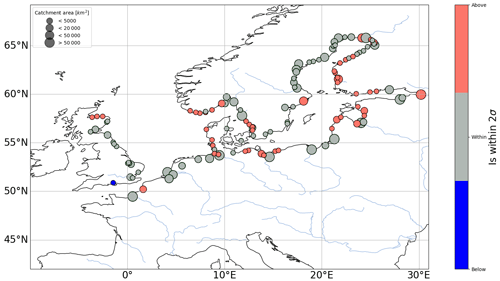
Figure A1HD5–ERA5 as in Fig. 3 but with ECOSMO–REA6 for the sea level data.
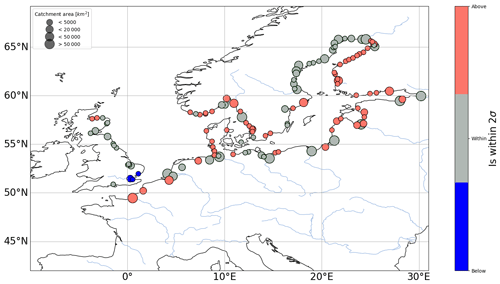
Figure A2As in Fig. 3 but with ECOSMO–coastDat3 and HD5–E-OBS data.
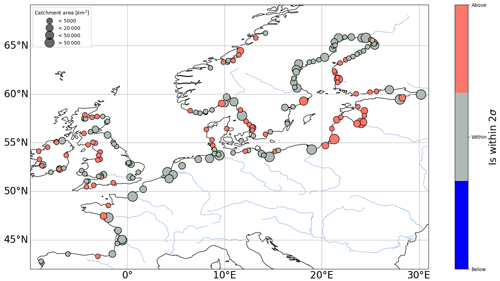
Figure A3TRIM–REA6 and HD5–ERA5 as in Fig. 3 but utilising normal percentile instead of the adaptive thresholds.
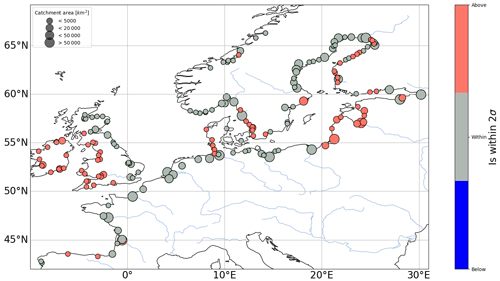
Figure A4TRIM–REA6 and HD5–ERA5 as in Fig. 3 but for the months of November to February.
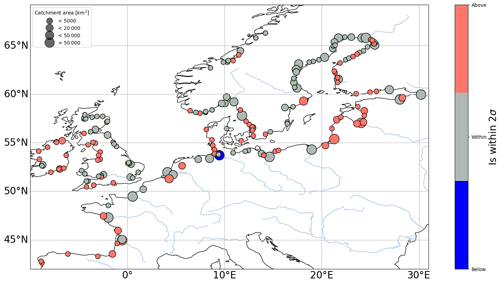
Figure A5TRIM–REA6 and HD5–ERA5 as in Fig. 3 but for the months of October to March.
The HD discharge data can be obtained at the World Data Centre for Climate (WDCC) of the German Climate Computing Centre (DKRZ; https://doi.org/10.26050/WDCC/EOBS_ERA5-River_Runoff, Hagemann and Stacke, 2021). TRIM and ECOSMO sea level data will be made available by the authors, without undue reservation, to any qualified researcher upon request. ERA5 reanalysis data are available at the Climate Data Store: https://doi.org/10.24381/cds.adbb2d47 (Hersbach et al., 2023). DWD Großwetterlagen are available at https://www.dwd.de/DE/leistungen/grosswetterlage/grosswetterlage.html (DWD, 2023).
PH developed the analysis methods, performed the data analysis, and wrote the manuscript. SH initiated the study and contributed the HD discharge data, while LG and UD generated the TRIM and ECOSMO sea level data, respectively. CS revised the manuscript. RW and SH revised the manuscript and contributed to the interpretation of the results. RW acquired the funding, and SH, RW, and CS supervised the research activities.
The contact author has declared that none of the authors has any competing interests.
Publisher's note: Copernicus Publications remains neutral with regard to jurisdictional claims in published maps and institutional affiliations.
This research is a contribution to the PoFIV programme of the Helmholtz Association.
This research has been supported by the Bundesministerium für Bildung und Forschung (grant no. 01LR2003A).
The article processing charges for this open-access publication were covered by the Helmholtz-Zentrum Hereon.
This paper was edited by Piero Lionello and reviewed by two anonymous referees.
Allen, R. G., Pereira, L. S., Raes, D., and Smith, M.: Crop evapotranspiration-Guidelines for computing crop water requirements-FAO Irrigation and drainage paper 56, Fao, Rome, 300, D05109, ISBN 92-5-104219-5, 1998. a
Bermúdez, M., Farfán, J., Willems, P., and Cea, L.: Assessing the effects of climate change on compound flooding in coastal river areas, Water Resour. Res., 57, e2020WR029321, https://doi.org/10.1029/2020WR029321, 2021. a
Bevacqua, E., Maraun, D., Vousdoukas, M. I., Voukouvalas, E., Vrac, M., Mentaschi, L., and Widmann, M.: Higher probability of compound flooding from precipitation and storm surge in Europe under anthropogenic climate change, Science Advances, 5, eaaw5531, https://doi.org/10.1126/sciadv.aaw5531, 2019. a, b, c, d
Bevacqua, E., Vousdoukas, M. I., Zappa, G., Hodges, K., Shepherd, T. G., Maraun, D., Mentaschi, L., and Feyen, L.: More meteorological events that drive compound coastal flooding are projected under climate change, Communications Earth & Environment, 1, 1–11, https://doi.org/10.1038/s43247-020-00044-z, 2020. a
Bilskie, M. and Hagen, S.: Defining flood zone transitions in low-gradient coastal regions, Geophys. Res. Lett., 45, 2761–2770, https://doi.org/10.1002/2018GL077524, 2018. a
Bollmeyer, C., Keller, J.D., Ohlwein, C., Wahl, S., Crewell, S., Friederichs, P., Hense, A., Keune, J., Kneifel, S., Pscheidt, I., Redl, S., and Steinke, S.: Towards a high-resolution regional reanalysis for the European CORDEX domain, Q. J. Roy. Meteor. Soc., 141, 1–15, https://doi.org/10.1002/qj.2486, 2015. a
Bundesamt für Seeschifffahrt und Hydrographie: Report on the oceanographic conditions at site N-7.2, https://pinta.bsh.de/N-7.2?tab=daten/N-07-02_oceanography_report_EN.pdf (last access: 19 April 2022), 2022. a
Camus, P., Haigh, I. D., Nasr, A. A., Wahl, T., Darby, S. E., and Nicholls, R. J.: Regional analysis of multivariate compound coastal flooding potential around Europe and environs: sensitivity analysis and spatial patterns, Nat. Hazards Earth Syst. Sci., 21, 2021–2040, https://doi.org/10.5194/nhess-21-2021-2021, 2021. a, b
Chen, W.-B. and Liu, W.-C.: Modeling flood inundation induced by river flow and storm surges over a river basin, Water, 6, 3182–3199, https://doi.org/10.3390/w6103182, 2014. a
Cornes, R. C., van der Schrier, G., van den Besselaar, E. J., and Jones, P. D.: An ensemble version of the E-OBS temperature and precipitation data sets, J. Geophys. Res.-Atmos., 123, 9391–9409, https://doi.org/10.1029/2017JD028200, 2018. a
Couasnon, A., Eilander, D., Muis, S., Veldkamp, T. I. E., Haigh, I. D., Wahl, T., Winsemius, H. C., and Ward, P. J.: Measuring compound flood potential from river discharge and storm surge extremes at the global scale, Nat. Hazards Earth Syst. Sci., 20, 489–504, https://doi.org/10.5194/nhess-20-489-2020, 2020. a
Daewel, U. and Schrum, C.: Simulating long-term dynamics of the coupled North Sea and Baltic Sea ecosystem with ECOSMO II: Model description and validation, J. Marine Syst., 119, 30–49, https://doi.org/10.1016/j.jmarsys.2013.03.008, 2013. a
Davenport, F. V., Burke, M., and Diffenbaugh, N. S.: Contribution of historical precipitation change to US flood damages, P. Natl. Acad. Sci. USA, 118, e2017524118, https://doi.org/10.1073/pnas.2017524118, 2021. a
de Ruiter, M. C., Couasnon, A., van den Homberg, M. J., Daniell, J. E., Gill, J. C., and Ward, P. J.: Why we can no longer ignore consecutive disasters, Earths Future, 8, e2019EF001425, https://doi.org/10.1029/2019EF001425, 2020. a
Dietz, M.: Veränderungen der Großwetterlagen Mitteleuropas und ihr Einfluss auf die Hochwassergefahr an großen Flüssen in Deutschland, Master's thesis, Albert-Ludwigs-Universität Freiburg, http://www.hydrology.uni-freiburg.de/abschluss/Dietz_M_2019_MA.pdf (last access: 26 May 2023), 2019. a
DWD: Großwetterlagenklassifikation, DWD, Vorhersage- und Beratungszentrale [data set], https://www.dwd.de/DE/leistungen/grosswetterlage/grosswetterlage.html, last access: 26 May 2023. a
Engeland, K., Hisdal, H., and Frigessi, A.: Practical extreme value modelling of hydrological floods and droughts: a case study, Extremes, 7, 5–30, https://doi.org/10.1007/s10687-004-4727-5, 2004. a
European Commission and Directorate-General for European Civil Protection and Humanitarian Aid Operations (ECHO): Overview of natural and man-made disaster risks the European Union may face: 2020 edition, Publications Office, https://doi.org/10.2795/19072, 2021. a
Fang, J., Wahl, T., Fang, J., Sun, X., Kong, F., and Liu, M.: Compound flood potential from storm surge and heavy precipitation in coastal China: dependence, drivers, and impacts, Hydrol. Earth Syst. Sci., 25, 4403–4416, https://doi.org/10.5194/hess-25-4403-2021, 2021. a
Feser, F., Barcikowska, M., Krueger, O., Schenk, F., Weisse, R., and Xia, L.: Storminess over the North Atlantic and northwestern Europe – A review, Q. J. Roy. Meteor. Soc., 141, 350–382, https://doi.org/10.1002/qj.2364, 2015. a
Feyen, L., Ciscar, J.C., Gosling, S., Ibarreta, D., and Soria, A.: Climate change impacts and adaptation in Europe. JRC PESETA IV final report, Tech. rep., Joint Research Centre (Seville site), https://doi.org/10.2760/171121, 2020. a
Ganguli, P. and Merz, B.: Trends in compound flooding in northwestern Europe during 1901–2014, Geophys. Res. Lett., 46, 10810–10820, https://doi.org/10.1029/2019GL084220, 2019. a
Ganguli, P., Paprotny, D., Hasan, M., Güntner, A., and Merz, B.: Projected changes in compound flood hazard from riverine and coastal floods in northwestern Europe, Earths Future, 8, e2020EF001752, https://doi.org/10.1029/2020EF001752, 2020. a, b, c, d
Gerstengarbe, F.-W., Werner, P. C., and Rüge, U.: Katalog der Grosswetterlagen Europas (1881–1998) nach Paul Hess und Helmuth Brezowsky, Potsdam-Institut für Klimafolgenforschung, https://www.pik-potsdam.de/en/output/publications/pikreports/.files/pr119.pdf (last access: 26 May 2023), 1999. a
Geyer, B.: High-resolution atmospheric reconstruction for Europe 1948–2012: coastDat2, Earth Syst. Sci. Data, 6, 147–164, https://doi.org/10.5194/essd-6-147-2014, 2014. a
Grabau, J.: Klimaschwankungen und Grosswetterlagen in Mitteleuropa seit 1881, Geogr. Helv., 42, 35–40, https://doi.org/10.5194/gh-42-35-1987, 1987. a
Gumbel, E. J.: Statistics of extremes, Columbia university press, https://doi.org/10.7312/gumb92958, 1958. a
Hagemann, S. and Ho-Hagemann, H. T.: The Hydrological Discharge Model – a river runoff component for offline and coupled model applications, Zenodo [code], https://doi.org/10.5281/zenodo.4893099, 2021. a
Hagemann, S. and Stacke, T.: Forcing for HD Model from HydroPy and subsequent HD Model river runoff over Europe based on EOBS22 and ERA5 data, World Data Center for Climate (WDCC) at DKRZ [data set], https://doi.org/10.26050/WDCC/EOBS_ERA5-River_Runoff, 2021. a, b
Hagemann, S. and Stacke, T.: Complementing ERA5 and E-OBS with high-resolution river discharge over Europe, Oceanologia, 65, 230–248, https://doi.org/10.1016/j.oceano.2022.07.003, 2022. a, b
Hagemann, S., Stacke, T., and Ho-Hagemann, H.: High resolution discharge simulations over Europe and the Baltic Sea catchment, Front. Earth Sci., 8, 12, https://doi.org/10.3389/feart.2020.00012, 2020. a
Haigh, I. D., Wadey, M. P., Wahl, T., Ozsoy, O., Nicholls, R. J., Brown, J. M., Horsburgh, K., and Gouldby, B.: Spatial and temporal analysis of extreme sea level and storm surge events around the coastline of the UK, Scientific Data, 3, 1–14, https://doi.org/10.1038/sdata.2016.107, 2016. a
Hao, Z., Singh, V. P., and Hao, F.: Compound extremes in hydroclimatology: a review, Water, 10, 718, https://doi.org/10.3390/w10060718, 2018. a
Harley, M.: Coastal storm definition, Coastal Storms: Processes and Impacts, edited by: Ciavola, P. and Coco, G., John Wiley and Sons, Chichester, UK, 1–21, https://doi.org/10.1002/9781118937099.ch1, 2017. a, b
Harris, C. R., Millman, K. J., van der Walt, S. J., Gommers, R., Virtanen, P., Cournapeau, D., Wieser, E., Taylor, J., Berg, S., Smith, N. J., Kern, R., Picus, M., Hoyer, S., van Kerkwijk, M. H., Brett, M., Haldane, A., del Río, J. F., Wiebe, M., Peterson, P., Gérard-Marchant, P., Sheppard, K., Reddy, T., Weckesser, W., Abbasi, H., Gohlke, C., and Oliphant, T. E.: Array programming with NumPy, Nature, 585, 357–362, https://doi.org/10.1038/s41586-020-2649-2, 2020. a
Hendry, A., Haigh, I. D., Nicholls, R. J., Winter, H., Neal, R., Wahl, T., Joly-Laugel, A., and Darby, S. E.: Assessing the characteristics and drivers of compound flooding events around the UK coast, Hydrol. Earth Syst. Sci., 23, 3117–3139, https://doi.org/10.5194/hess-23-3117-2019, 2019. a, b, c
Hersbach, H., Bell, B., Berrisford, P., Hirahara, S., Horányi, A., Muñoz-Sabater, J., Nicolas, J., Peubey, C., Radu, R., Schepers, D., Simmons, A., Soci, C., Abdalla, S., Abellan, X., Balsamo, G., Bechtold, P., Biavati, G., Bidlot, J., Bonavita, M., De Chiara, G., Dahlgren, P., Dee, D., Diamantakis, M., Dragani, R., Flemming, J., Forbes, R., Fuentes, M., Geer, A., Haimberger, L., Healy, S., Hogan, R. J., Hólm, E., Janisková, M., Keeley, S., Laloyaux, P., Lopez, P., Lupu, C., Radnoti, G., de Rosnay, P., Rozum, I., Vamborg, F., Villaume, S., and Thépaut, J.-N.: The ERA5 global reanalysis, Q. J. Roy. Meteor. Soc., 146, 1999–2049, https://doi.org/10.1002/qj.3803, 2020. a, b
Hersbach, H., Bell, B., Berrisford, P., Biavati, G., Horányi, A., Muñoz Sabater, J., Nicolas, J., Peubey, C., Radu, R., Rozum, I., Schepers, D., Simmons, A., Soci, C., Dee, D., and Thépaut, J.-N.: ERA5 hourly data on single levels from 1940 to present, Copernicus Climate Change Service (C3S) Climate Data Store (CDS) [data set], https://doi.org/10.24381/cds.adbb2d47, 2023. a
Hess, P. and Brezowsky, H.: Katalog der Grosswetterlagen Europas, Dt. Wetterdienst, ISSN 0072-4130, 1969. a
Hoy, A., Sepp, M., and Matschullat, J.: Atmospheric circulation variability in Europe and northern Asia (1901 to 2010), Theor. Appl. Climatol., 113, 105–126, https://doi.org/10.1007/s00704-012-0770-3, 2013. a
Jaagus, J., Briede, A., Rimkus, E., and Remm, K.: Precipitation pattern in the Baltic countries under the influence of large-scale atmospheric circulation and local landscape factors, Int. J. Climatol., 30, 705–720, https://doi.org/10.1002/joc.1929, 2010. a
James, P.: An objective classification method for Hess and Brezowsky Grosswetterlagen over Europe, Theor. Appl. Climatol., 88, 17–42, https://doi.org/10.1007/s00704-006-0239-3, 2007. a
Jane, R., Wahl, T., Santos, V. M., Misra, S. K., and White, K. D.: Assessing the Potential for Compound Storm Surge and Extreme River Discharge Events at the Catchment Scale with Statistical Models: Sensitivity Analysis and Recommendations for Best Practice, J. Hydrol. Eng., 27, https://doi.org/10.1061/(ASCE)HE.1943-5584.0002154, 2022. a
Joe, H.: Dependence modeling with copulas, CRC press, ISBN 9781032477374, 2014. a
Juarez, B., Stockton, S. A., Serafin, K. A., and Valle-Levinson, A.: Compound flooding in a subtropical estuary caused by Hurricane Irma 2017, Geophys. Res. Lett., 49, e2022GL099360, https://doi.org/10.1029/2022GL099360, 2022. a
Kalnay, E., Kanamitsu, M., Kistler, R., Collins, W., Deaven, D., Gandin, L., Iredell, M., Saha, S., White, G., Woollen, J., Zhu, Y., Chelliah, M., Ebisuzaki, W., Higgins, W., Janowiak, J., Mo, K. C., Ropelewski, C., Wang, J., Leetmaa, A., Reynolds, R., Roy, J., and Joseph, D.: The NCEP/NCAR 40-year reanalysis project, B. Am. Meteorol. Soc., 77, 437–472, https://doi.org/10.1175/1520-0477(1996)077<0437:TNYRP>2.0.CO;2, 1996. a
Kapitza, H.: MOPS – a morphodynamical prediction system on cluster computers, in: International Conference on High Performance Computing for Computational Science, Springer, 63–68, https://doi.org/10.1007/978-3-540-92859-1_8, 2008. a
Kew, S. F., Selten, F. M., Lenderink, G., and Hazeleger, W.: The simultaneous occurrence of surge and discharge extremes for the Rhine delta, Nat. Hazards Earth Syst. Sci., 13, 2017–2029, https://doi.org/10.5194/nhess-13-2017-2013, 2013. a
Khanal, S., Lutz, A. F., Immerzeel, W. W., Vries, H. D., Wanders, N., and Hurk, B. V. D.: The impact of meteorological and hydrological memory on compound peak flows in the Rhine river basin, Atmosphere, 10, 171, https://doi.org/10.3390/atmos10040171, 2019. a
Klein Tank, A., Wijngaard, J., Können, G., Böhm, R., Demarée, G., Gocheva, A., Mileta, M., Pashiardis, S., Hejkrlik, L., Kern-Hansen, C., Heino, R., Bessemoulin, P., Müller-Westermeier, G., Tzanakou, M., Szalai, S., Pálsdóttir, T., Fitzgerald, D., Rubin, S., Capaldo, M., Maugeri, M., Leitass, A., Bukantis, A., Aberfeld, R., van Engelen, A. F. V., Forland, E., Mietus, M., Coelho, F., Mares, C., Razuvaev, V., Nieplova, E., Cegnar, T., Antonio López, J., Dahlström, B., Moberg, A., Kirchhofer, W., Ceylan, A., Pachaliuk, O., Alexander, L. V., and Petrovic, P.: Daily dataset of 20th-century surface air temperature and precipitation series for the European Climate Assessment, Int. J. Climatol., 22, 1441–1453, https://doi.org/10.1002/joc.773, 2002. a
Klok, E. and Klein Tank, A.: Updated and extended European dataset of daily climate observations, Int. J. Climatol., 29, 1182–1191, https://doi.org/10.1002/joc.1779, 2009. a
Kumbier, K., Carvalho, R. C., Vafeidis, A. T., and Woodroffe, C. D.: Investigating compound flooding in an estuary using hydrodynamic modelling: a case study from the Shoalhaven River, Australia, Nat. Hazards Earth Syst. Sci., 18, 463–477, https://doi.org/10.5194/nhess-18-463-2018, 2018. a
Lai, Y., Li, J., Gu, X., Liu, C., and Chen, Y. D.: Global compound floods from precipitation and storm surge: hazards and the roles of cyclones, J. Climate, 34, 8319–8339, https://doi.org/10.1175/JCLI-D-21-0050.1, 2021. a
Leonard, M., Westra, S., Phatak, A., Lambert, M., van den Hurk, B., McInnes, K., Risbey, J., Schuster, S., Jakob, D., and Stafford-Smith, M.: A compound event framework for understanding extreme impacts, WIRES Climate Change, 5, 113–128, https://doi.org/10.1002/wcc.252, 2014. a
Lian, J. J., Xu, K., and Ma, C.: Joint impact of rainfall and tidal level on flood risk in a coastal city with a complex river network: a case study of Fuzhou City, China, Hydrol. Earth Syst. Sci., 17, 679–689, https://doi.org/10.5194/hess-17-679-2013, 2013. a
Liang, B., Shao, Z., Li, H., Shao, M., and Lee, D.: An automated threshold selection method based on the characteristic of extrapolated significant wave heights, Coast. Eng., 144, 22–32, https://doi.org/10.1016/j.coastaleng.2018.12.001, 2019. a
Liu, X., Meinke, I., and Weisse, R.: Still normal? Near-real-time evaluation of storm surge events in the context of climate change, Nat. Hazards Earth Syst. Sci., 22, 97–116, https://doi.org/10.5194/nhess-22-97-2022, 2022. a
Lyard, F., Lefevre, F., Letellier, T., and Francis, O.: Modelling the global ocean tides: modern insights from FES2004, Ocean Dynam., 56, 394–415, https://doi.org/10.1007/s10236-006-0086-x, 2006. a
McGranahan, G., Balk, D., and Anderson, B.: The rising tide: assessing the risks of climate change and human settlements in low elevation coastal zones, Environ. Urban., 19, 17–37, https://doi.org/10.1177/0956247807076960, 2007. a
Moftakhari, H., Schubert, J. E., AghaKouchak, A., Matthew, R. A., and Sanders, B. F.: Linking statistical and hydrodynamic modeling for compound flood hazard assessment in tidal channels and estuaries, Adv. Water Resour., 128, 28–38, https://doi.org/10.1016/j.advwatres.2019.04.009, 2019. a
Müller, M. and Sacco, D.: Coastlines in crisis: key risks from rising oceans, CIO Special, Deutsche Bank Chief Investment Office, https://www.deutschewealth.com/dam/deutschewealth/cio-perspectives/cio-special-assets/coastlines-in-crisis/CIO-Special-Coastlines-in-crisis-key-risks-from-rising-oceans.pdf (last access: 6 May 2023), 2021. a
Nasr, A. A., Wahl, T., Rashid, M. M., Camus, P., and Haigh, I. D.: Assessing the dependence structure between oceanographic, fluvial, and pluvial flooding drivers along the United States coastline, Hydrol. Earth Syst. Sci., 25, 6203–6222, https://doi.org/10.5194/hess-25-6203-2021, 2021. a
Paprotny, D., Morales-Nápoles, O., and Jonkman, S. N.: HANZE: a pan-European database of exposure to natural hazards and damaging historical floods since 1870, Earth Syst. Sci. Data, 10, 565–581, https://doi.org/10.5194/essd-10-565-2018, 2018a. a
Paprotny, D., Vousdoukas, M. I., Morales-Nápoles, O., Jonkman, S. N., and Feyen, L.: Compound flood potential in Europe, Hydrol. Earth Syst. Sci. Discuss. [preprint], https://doi.org/10.5194/hess-2018-132, 2018b. a
Paprotny, D., Vousdoukas, M. I., Morales-Nápoles, O., Jonkman, S. N., and Feyen, L.: Pan-European hydrodynamic models and their ability to identify compound floods, Nat. Hazards, 101, 933–957, https://doi.org/10.1007/s11069-020-03902-3, 2020. a, b
Petrik, R. and Geyer, B.: coastDat3 COSMO-CLM MERRA2, World Data Center for Climate (WDCC) at DKRZ [data set], https://doi.org/10.26050/WDCC/coastDat3_COSMO-CLM_MERRA2, 2021. a
Pickands III, J.: Statistical inference using extreme order statistics, Ann. Stat., 3, 119–131, 1975. a
Poschlod, B., Zscheischler, J., Sillmann, J., Wood, R. R., and Ludwig, R.: Climate change effects on hydrometeorological compound events over southern Norway, Weather and Climate Extremes, 28, 100253, https://doi.org/10.1016/j.wace.2020.100253, 2020. a, b
Rakovec, O. and Kumar, R.: Mesoscale Hydrologic Model based historical streamflow simulation over Europe at degree, World Data Center for Climate (WDCC) at DKRZ [data set], https://doi.org/10.26050/WDCC/mHMbassimEur, 2022. a
Rantanen, M., Jylhä, K., Särkkä, J., Räihä, J., and Leijala, U.: Characteristics of joint heavy precipitation and high sea level events on the Finnish coast in 1961–2020, Nat. Hazards Earth Syst. Sci. Discuss. [preprint], https://doi.org/10.5194/nhess-2021-314, 2021. a
Ridder, N., de Vries, H., and Drijfhout, S.: The role of atmospheric rivers in compound events consisting of heavy precipitation and high storm surges along the Dutch coast, Nat. Hazards Earth Syst. Sci., 18, 3311–3326, https://doi.org/10.5194/nhess-18-3311-2018, 2018. a
Rivoire, P., Martius, O., and Naveau, P.: A comparison of moderate and extreme ERA-5 daily precipitation with two observational data sets, Earth Space Sci., 8, e2020EA001633, https://doi.org/10.1029/2020EA001633, 2021. a
Robins, P. E., Lewis, M. J., Elnahrawi, M., Lyddon, C., Dickson, N., and Coulthard, T. J.: Compound flooding: Dependence at sub-daily scales between extreme storm surge and fluvial flow, Frontiers in Built Environment, 7, p. 116, https://doi.org/10.3389/fbuil.2021.727294, 2021. a
Rockel, B., Will, A., and Hense, A.: The regional climate model COSMO-CLM (CCLM), Meteorol. Z., 17, 347–348, https://doi.org/10.1127/0941-2948/2008/0309, 2008. a
Santos, V. M., Casas-Prat, M., Poschlod, B., Ragno, E., van den Hurk, B., Hao, Z., Kalmár, T., Zhu, L., and Najafi, H.: Statistical modelling and climate variability of compound surge and precipitation events in a managed water system: a case study in the Netherlands, Hydrol. Earth Syst. Sci., 25, 3595–3615, https://doi.org/10.5194/hess-25-3595-2021, 2021a. a
Santos, V. M., Wahl, T., Jane, R., Misra, S. K., and White, K. D.: Assessing compound flooding potential with multivariate statistical models in a complex estuarine system under data constraints, J. Flood Risk Manage., 14, e12749, https://doi.org/10.1111/jfr3.12749, 2021b. a
Schrum, C. and Backhaus, J. O.: Sensitivity of atmosphere–ocean heat exchange and heat content in the North Sea and the Baltic Sea, Tellus A, 51, 526–549, https://doi.org/10.1034/j.1600-0870.1992.00006.x, 1999. a
Seneviratne, S., Nicholls, N., Easterling, D., Goodess, C., Kanae, S., Kossin, J., Luo, Y., Marengo, J., McInnes, K., Rahimi, M., Reichstein, M., Sorteberg, A., Vera, C., Zhang, X., Alexander, L. V., Allen, S., Benito, G., Cavazos, T., Clague, J., Conway, D., Della-Marta, P. M., Gerber, M., Gong, S., Goswami, B. N., Hemer, M., Huggel, C., van den Hurk, B., Kharin, V. V., Kitoh, A., Klein Tank, A. M. G., Li, G., Mason, S. J., McGuire, W., van Oldenborgh, G. J., Orlowsky, B., Smith, S., Thiaw, W., Velegrakis, A., Yiou, P., Zhang, T., Zhou, T., and Zwiers, F. W.: Changes in climate extremes and their impacts on the natural physical environment, Cambridge University Press, https://doi.org/10.7916/d8-6nbt-s431, 2012. a
Serinaldi, F.: An uncertain journey around the tails of multivariate hydrological distributions, Water Resour. Res., 49, 6527–6547, https://doi.org/10.1002/wrcr.20531, 2013. a
Solari, S., Egüen, M., Polo, M. J., and Losada, M. A.: Peaks Over Threshold (POT): A methodology for automatic threshold estimation using goodness of fit p-value, Water Resour. Res., 53, 2833–2849, 2017. a
Stacke, T. and Hagemann, S.: HydroPy (v1.0): a new global hydrology model written in Python, Geosci. Model Dev., 14, 7795–7816, https://doi.org/10.5194/gmd-14-7795-2021, 2021. a
Svensson, C. and Jones, D. A.: Dependence between extreme sea surge, river flow and precipitation in eastern Britain, Int. J. Climatol., 22, 1149–1168, https://doi.org/10.1002/joc.794, 2002. a, b
Svensson, C. and Jones, D. A.: Dependence between sea surge, river flow and precipitation in south and west Britain, Hydrol. Earth Syst. Sci., 8, 973–992, https://doi.org/10.5194/hess-8-973-2004, 2004. a
Thornthwaite, C. W.: An approach toward a rational classification of climate, Geogr. Rev., 38, 55–94, 1948. a
United Nations: Factsheet: People and Oceans, United Nations, https://www.un.org/sustainabledevelopment/wp-content/uploads/2017/05/Ocean-fact-sheet-package.pdf (last access: 22 February 2022), 2017. a
van den Hurk, B., van Meijgaard, E., de Valk, P., van Heeringen, K.-J., and Gooijer, J.: Analysis of a compounding surge and precipitation event in the Netherlands, Environ. Res. Lett., 10, 035001, https://doi.org/10.1088/1748-9326/10/3/035001, 2015. a, b
von Storch, H., Langenberg, H., and Feser, F.: A spectral nudging technique for dynamical downscaling purposes, Mon. Weather Rev., 128, 3664–3673, https://doi.org/10.1175/1520-0493(2000)128<3664:ASNTFD>2.0.CO;2, 2000. a
Vousdoukas, M. I., Mentaschi, L., Voukouvalas, E., Bianchi, A., Dottori, F., and Feyen, L.: Climatic and socioeconomic controls of future coastal flood risk in Europe, Nat. Clim. Change, 8, 776–780, https://doi.org/10.1038/s41558-018-0260-4, 2018. a
Ward, P. J., Couasnon, A., Eilander, D., Haigh, I. D., Hendry, A., Muis, S., Veldkamp, T. I., Winsemius, H. C., and Wahl, T.: Dependence between high sea-level and high river discharge increases flood hazard in global deltas and estuaries, Environ. Res. Lett., 13, 084012, https://doi.org/10.1088/1748-9326/aad400, 2018. a, b, c
Xu, H., Tian, Z., Sun, L., Ye, Q., Ragno, E., Bricker, J., Mao, G., Tan, J., Wang, J., Ke, Q., Wang, S., and Toumi, R.: Compound flood impact of water level and rainfall during tropical cyclone periods in a coastal city: the case of Shanghai, Nat. Hazards Earth Syst. Sci., 22, 2347–2358, https://doi.org/10.5194/nhess-22-2347-2022, 2022. a
Zheng, F., Westra, S., and Sisson, S. A.: Quantifying the dependence between extreme rainfall and storm surge in the coastal zone, J. Hydrol., 505, 172–187, https://doi.org/10.1016/j.jhydrol.2013.09.054, 2013. a
Zheng, F., Westra, S., Leonard, M., and Sisson, S. A.: Modeling dependence between extreme rainfall and storm surge to estimate coastal flooding risk, Water Resour. Res., 50, 2050–2071, https://doi.org/10.1002/2013WR014616, 2014. a
Zscheischler, J., Westra, S., van den Hurk, B. J. J. M., Seneviratne, S. I., Ward, P. J., Pitman, A., AghaKouchak, A., Bresch, D. N., Leonard, M., Wahl, T., and Zhang, X.: Future climate risk from compound events, Nat. Clim. Change, 8, 469–477, https://doi.org/10.1038/s41558-018-0156-3, 2018. a






